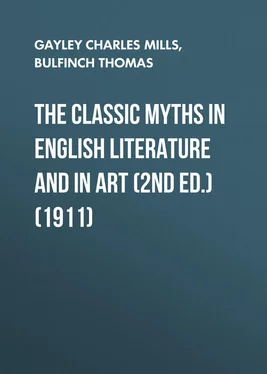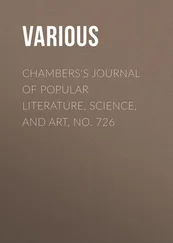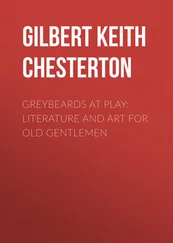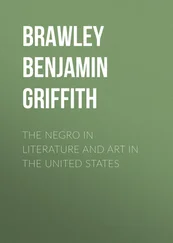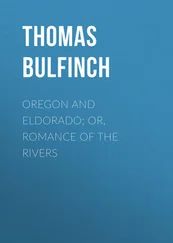Thomas Bulfinch - The Classic Myths in English Literature and in Art (2nd ed.) (1911)
Здесь есть возможность читать онлайн «Thomas Bulfinch - The Classic Myths in English Literature and in Art (2nd ed.) (1911)» — ознакомительный отрывок электронной книги совершенно бесплатно, а после прочтения отрывка купить полную версию. В некоторых случаях можно слушать аудио, скачать через торрент в формате fb2 и присутствует краткое содержание. Жанр: foreign_antique, foreign_prose, на английском языке. Описание произведения, (предисловие) а так же отзывы посетителей доступны на портале библиотеки ЛибКат.
- Название:The Classic Myths in English Literature and in Art (2nd ed.) (1911)
- Автор:
- Жанр:
- Год:неизвестен
- ISBN:нет данных
- Рейтинг книги:4 / 5. Голосов: 1
-
Избранное:Добавить в избранное
- Отзывы:
-
Ваша оценка:
- 80
- 1
- 2
- 3
- 4
- 5
The Classic Myths in English Literature and in Art (2nd ed.) (1911): краткое содержание, описание и аннотация
Предлагаем к чтению аннотацию, описание, краткое содержание или предисловие (зависит от того, что написал сам автор книги «The Classic Myths in English Literature and in Art (2nd ed.) (1911)»). Если вы не нашли необходимую информацию о книге — напишите в комментариях, мы постараемся отыскать её.
The Classic Myths in English Literature and in Art (2nd ed.) (1911) — читать онлайн ознакомительный отрывок
Ниже представлен текст книги, разбитый по страницам. Система сохранения места последней прочитанной страницы, позволяет с удобством читать онлайн бесплатно книгу «The Classic Myths in English Literature and in Art (2nd ed.) (1911)», без необходимости каждый раз заново искать на чём Вы остановились. Поставьте закладку, и сможете в любой момент перейти на страницу, на которой закончили чтение.
Интервал:
Закладка:
But above all things should be cultivated, by means of this study, the spiritual capabilities of our youth. Pabulum for thought, accurate habits of memory, critical judgment, simplicity and directness of oral and written expression, may all be furnished or developed by other educative agencies; but what stimulus to fancy, to poetic sensitiveness and reflection, to a near kinship with the spirit of nature humanized, can be found more cogent than the contemplation of the poetic traditions that abide in verse? Mythology, fraught with the fire of imagination, kindles the present from the past.
In this new world of ours, shall slopes and mountains, gorges, cañons, flowery fields and forests, rivers, bays, Titanic lakes, and shoreless reach of ocean be seen of eyes that lack insight, be known of men for whom nature does not live? Surely the age of myth is not wholly past; surely the beauties and the wonders of nature are a fable of things never fully revealed; surely this new republic of ours, no less than her prototypes by Tyrrhenian and Ægean seas, utters, in her queenly form and flowing robes, a spirit, a truth, a potential poetry, and a beauty of art, the grace of which we Americans, with deeper imaginative training and sympathy and awe, may yet more highly value and more clearly comprehend.
2. Of the Classic Myths in their Relation to Art. 1 1 See Preface.
The illustration of a book on ancient mythology offers great difficulties, because the modern reader expects one thing and the ancient artist, on whose works one must rely, intentionally offers a very different thing. We have grown to be a reading people, forming our ideas largely on the written word, while in antiquity the spoken word opened the door to understanding. A story which has been committed to writing is fixed for all time, having lost its power of growth; whereas a tale that passes from mouth to mouth, with no record by which to check its accuracy in particulars, is free to expand. It changes with the moods of those who tell it, and the intellectual and moral standards of those who listen. People to-day are unimaginative and literal. They also expect that the pictures which illustrate their books shall follow the individual conceptions of the author closely. When the story is dramatized a certain latitude is granted to the actor; the artist, however, who illustrates the book has no such freedom. He is expected to take precisely the author's view of a fictitious character, and, consequently, his individuality may show itself only in the technique. In antiquity there were no standard books of fiction or of myths. When writing came into use with the sixth century before Christ, the individual versions of this or that great epic poem or drama were preserved; but the great mass of the people knew them, not because they had read the manuscripts, but because they had heard them acted or recited. Book illustrations, therefore, were unknown. Yet so powerful was the impression which the myths made on the people that most of the artists drew their inspiration from them. Artists and poets alike wished to make real the powerful characters of Greek tradition. To make a literally true illustration of any one version of a great myth was not the aim of a classic artist.
Another difficulty is found in the fact that few ancient myths continued to be equally interesting to the people all the time. It is therefore necessary for us, in choosing illustrations, to draw on all periods of ancient art, the crude beginning and the decline as well as the brief span of fine art. The comparatively meager store of genuinely classic works of art acts as one of the greatest obstacles to the compilation of a continuous record of classic myths in classic art. To give such a record, however, rather than to illustrate his book, must be the aim of the author who publishes to-day a version of ancient mythology together with such pictures or reliefs or statues as are preserved. The modern reader of such a book should therefore appreciate this fact: he must make allowance for the gradual development of ancient art. The picture is not there for the sake of strengthening the written work, but for its own sake. It often offers an independent version of the myth which he reads, and at all times may give him an insight into the mental make-up of the classic people.
Sculpture was the finest art of the Greeks, if one may judge by the remains. In this province the artists worked according to the best principles of art, making their appeal directly to the nobler side of man. Before an ancient statue one feels the power of an idea immediately, and not by the circuitous route of remembering a sequence of words which may have aimed to suggest a similar idea. The Greeks were the least literal in their sculpture. Their marbles, therefore, cannot yield illustrations which the modern editor can use, except when they embody, like the Demeter of Knidos (Fig. 29) or the Athena of Velletri (Fig. 10), a well-defined character-conception. The modern reader, on the other hand, cannot fail to notice that this conception never does justice to the character of the goddess as it appears in all the myths, and very rarely even to that characteristic which may dominate the particular version of any one myth. If such pictures, however, were entirely omitted from the book, the best means of appreciating the essential nobility of the Greek mind would be lost.
None of the Greek masterpieces of painting are extant. Their attenuated influence, however, may be traced in the Italian wall paintings from Pompeii and elsewhere. Painting permits greater literalness than sculpture. The picture from Herculaneum, for instance, – Io, Argus, and Mercury (Fig. 47), – tells a definite story and one which is also told by the poets. But the painter has considered the making of a pleasing picture first, and given only a secondary thought to accuracy of tradition. This must be so; for while we may without displeasure listen to the description of a monster, we cannot see his actual representation without discomfort. When we hear how the companions of Ulysses were turned into swine, the tragic note is never lost. To paint this scene, however, and not to border on the ridiculous or the burlesque is given only to the greatest artist – if it is at all possible.
Fortunately for our purposes of illustration, there was a class of secondary artists in Greece which did not always shrink from selecting subjects ill adapted for art, and from rendering them with slight variations so that they are neither bad to look at nor altogether untrue. These were the painters of vases. Some of them were masters of their craft (cf. Fig. 116), others were of only mediocre skill. All, however, like their nobler brethren, were primarily concerned with the decorative and technical side of their art and but secondarily with their subject. If the story, for instance, called for four persons and their space for five, they unhesitatingly added the fifth person, and, vice versa, removed one without compunction if they had place for fewer figures than the story demanded. Being, moreover, commercial people, they painted according to fashion. Whatever version of a myth happened to be popular, that they selected, so that it has been possible to trace by their vases the changes which several myths underwent from the sixth century onward.
A careful student notices the similarity of types in many of these pictures and realizes that the ancient painter of vases started out with a certain stock-in-trade which he altered as little as possible, adding something new only where it was absolutely necessary.
From these observations it is clear that the works of men who were least gifted artistically are the best adapted for the purposes of book illustrations; for a painter is literal in the inverse ratio of his worth as artist. Nothing, therefore, could be less fair than to judge Greek vase painting by the collection of pictures here offered. Only paintings like Figures 85 and 101, for instance, can give a hint of the best that these men produced.
Читать дальшеИнтервал:
Закладка:
Похожие книги на «The Classic Myths in English Literature and in Art (2nd ed.) (1911)»
Представляем Вашему вниманию похожие книги на «The Classic Myths in English Literature and in Art (2nd ed.) (1911)» списком для выбора. Мы отобрали схожую по названию и смыслу литературу в надежде предоставить читателям больше вариантов отыскать новые, интересные, ещё непрочитанные произведения.
Обсуждение, отзывы о книге «The Classic Myths in English Literature and in Art (2nd ed.) (1911)» и просто собственные мнения читателей. Оставьте ваши комментарии, напишите, что Вы думаете о произведении, его смысле или главных героях. Укажите что конкретно понравилось, а что нет, и почему Вы так считаете.
